硝基与亚硝基化合物
硝基化合物的性质

NaNO2, HCl 0-5oC -N2
现象
1o胺
RNH2 R+
+ [R-NN]Cl
1o胺放出N2气体
醇、烯、卤代烃等的混合物
R2NH NaNO2, HCl [R2N-N=O]
2o胺
R3N + HNO2
OH-
N-亚硝基
2o胺出现黄色油状物 3o胺发生成盐反应
3o胺
[R3NH]+NO2-
硝基化合物的性质——化学性质
含α-H的硝基烷在碱性条件下生成碳 负离子,作为亲核试剂参与反应。
C6H5CHO + CH3NO2 EtONa C6H5CH CHNO2
H2C CHCN
+
CH3NO2
EtONa
CNCH2CH2CH2NO2
第二节 胺
一、分类 胺根据在氮上的取代基的数目,可分为
NH2 NH N N
Hofmann消除例:
CH3 N(CH3)3 OH 99% NaOC2H5, HOC2H5 (NaOC2H5 作为碱) CH2 ' H3C H2C H2C N CH2 CH3 CH3 OH 1% CH2 + CH3
CH3 CH2 CH2
CH
CH3
CH2 CH2 CH CH3 96%
CH2
N(CH3)3 I
胺有碱性,遇酸能形成盐 RNH2 + CH3COOH CH3COO- +NH3R
(三)化学性质
应用例1:鉴别或定量分析
鉴定:溶于盐酸
定量分析:盐酸标液滴定(非水滴定)
(三)化学性质
应用例2:分离、提纯
混合物 盐酸溶解
经济学硝化和亚硝化

=
ω(H2SO4)
100-ω(H2SO4)-ω(HNO3)+2ω(HNO3)/7Φ
(Ф>1)
26
第27页/共63页
• Ф≤1时,可推出:
D.V.S. =
ω(H2SO4) 1- ω(H2SO4)-5/7 ω(HNO3)
注意:若为a﹪,则把a代入式中计算;若把式子中的 100改为1,则代入的是a﹪ )
废酸中硫酸的质量 废酸的总质量
×100%
=
ω(H2SO4)
100-5 ω(HNO3) / 7Φ
(或1)
×100%
(Ф>1)
29
第30页/共63页
• Ф≤1时,可推出:
F.N.A.
=
ω(H2SO4) 100-5ω(HNO3) / 7
×100%
30
第31页/共63页
以上公式表明,F.N.A.为常数时,ω(H2SO4)和 ω(HNO3)为线型关系。这表明 :满足相同废酸计算 含量的混酸组成是多种多样的。而真正具有实际意 义的混酸组成仅是直线中的一小段。
25
第26页/共63页
脱水值计算公式: ω(HNO3)和ω(H2SO4)——混酸中硝酸和硫酸的质量百分数, φ——硝酸比, 以100份质量混酸为计算基准: 混酸含水质量=100- ω(H2SO4)- ω(HNO3) 硝化生成水质量=(ω(HNO3)/φ)×18/63=2ω(HNO3)/7φ
D.V.S.
17
第18页/共63页
6.3 影响因素→ 6.3.4 搅拌
6.3.4 搅拌 良好的搅拌装置和冷却设备对提高传热和传质效
率非常重要。要求转数:小型设备:1100r/min; 工业生产:1~4m3硝化锅,转数400-100 r/min。 环式或泵式硝化器,2000-3000 r/min。 间歇硝化的开始阶段要严防停转,否则再启动时
硝基化合物

成环和重排
O R C CH2 R' 成环 O R + C CH2 R' 重排 R R' O R C CH2R' + N N O
+ + H2C N N C R
醛和环酮以重排产物为主,普通的酮主要生成环氧化物。酮分子中 与羰基相连的两个烃基不相同时,得到两种重排产物的混合物。
O R O R C CH2 H + + H2C N N C H + N N O R C CH3
H 重排
O + CH2N2
O CH2 + N N
O + N2
O C CH2 CH2N2 CH2
O C CH2 + N N
O C
环丙酮
3. 与酰氯反应
O R
脱去氯化氢
O R O H C CH2 Cl + -H+ N N O R C CH + N N + N N
+ + H2C N N C Cl
-Cl
R
第一节 硝基化合物
硝基化合物可分为脂肪族硝基化合物和芳香族硝基化合物。 硝基化合物的结构
CH3 + N O
Sp2杂化
O
O O
C-N 147pm , <ONO = 127
N-O
+ N
122pm
+ N O O
+ N
O O
P, π 共轭
CH3
NO2
μ= 3.5 D
硝基为强的吸电子基
厚 第十八章 止 其它含氮化合物
H2 O R'OH NH3 O O RCH2COR'
有机化学 含氮有机化合物
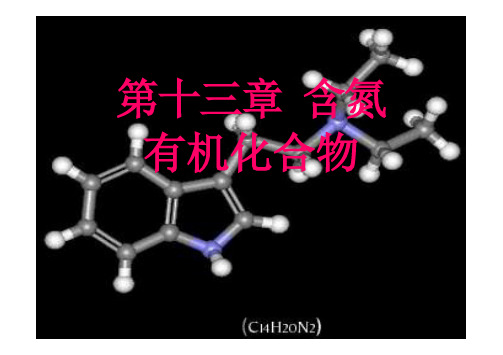
第十三章含氮有机化合物名称结构式名称结构式氨NH3胺RNH2,ArNH2R2NH (Ar)2NHR3N (Ar)3N氢氧化铵NH4OH季铵碱R4N+OH-铵盐NH4Cl季铵盐R4N+Cl-硝酸HO-NO2硝基化合物R-NO2 Ar-NO2亚硝酸HO-NO亚硝基化合物R-NO Ar-NO13.1硝基化合物由硝酸和亚硝酸可以导出四类含氮的有机物,即硝酸酯、亚硝酸酯、硝基化合物和亚硝基化合物H O NO2 R O NO2R NO2硝酸硝酸酯(补充)硝基化合物H O N O R O N O R N O亚硝酸亚硝酸酯亚硝基化合物一、 硝基化合物的命名和结构硝酸酯和亚硝酸酯的命名与有机酸酯的命名相同,如CH 3ONO 2CH 2CH 2ONO硝酸甲酯 亚硝酸乙酯(补充)2 硝基和亚硝基化合物中将硝基和亚硝基看作为取代基CH 3NO 2NO 2CH 3NO硝基甲烷 邻硝基甲苯 对亚硝基甲苯CH 3硝酸酯和芳香多硝基化合物都有爆炸性,常被用做炸药,如CH2ONO2CHONO2CH2ONO2O2NCH3NO2NO2三硝基甘油酯2,4,6-三硝基甲苯(TNT)硝基化合物的结构,可表示为由一个N=O和一个N→O配位键组成。
OR NO电子衍射法证明,硝基中两个氮氧键长是完全相同的,CH3NO2 分子中的两个N—O键的键长均为0.122nm。
原因:硝基中氮原子以sp2杂化,三个原子形成共平面的σ键。
二、硝基化合物的性质1、物理性质颜色多为淡黄色沸点比相应的卤代烃高, 常温下为高沸点的液体或结晶固体溶解性不溶于水,易溶于有机溶剂,液体的硝基化合物是有机化合物的良好的溶剂但是因为硝基化合物有毒性,可透过皮肤被机体吸收,生产上很少采用它,例如硝基苯有剧毒;多硝基化合物有爆炸性, 如2,4,6-三硝基甲苯(TNT)为烈性炸药2、脂肪族硝基化合物的化学性质(1)脂肪族硝基化合物的酸性硝基为吸电子基团,脂肪族硝基化合物中的-氢原子很活泼,显弱酸性,可与碱作用生成盐从而溶于碱中O R CH2NOOH R CH NORCH NO NaOH [ RCHNO ] - +H O2 2 + 2 Na + 2(2)与羰基化合物的缩合反应:有α-氢的硝基化合物,在碱性条件下可与醛或酮发生缩合反应,类似于羟醛缩合。
硝基与亚硝基化合物
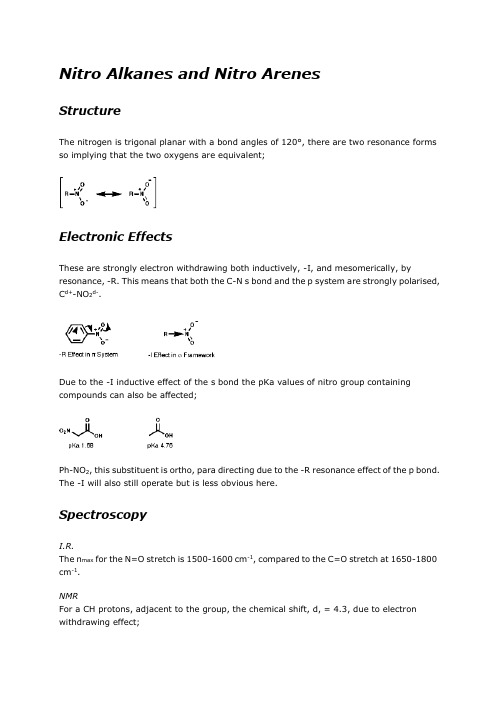
Nitro Alkanes and Nitro ArenesStructureThe nitrogen is trigonal planar with a bond angles of 120°, there are two resonance forms so implying that the two oxygens are equivalent;Electronic EffectsThese are strongly electron withdrawing both inductively, -I, and mesomerically, by resonance, -R. This means that both the C-N s bond and the p system are strongly polarised, C d+-NO2d-.Due to the -I inductive effect of the s bond the pKa values of nitro group containing compounds can also be affected;Ph-NO2, this substituent is ortho, para directing due to the -R resonance effect of the p bond. The -I will also still operate but is less obvious here.SpectroscopyI.R.The n max for the N=O stretch is 1500-1600 cm-1, compared to the C=O stretch at 1650-1800 cm-1.NMRFor a CH protons, adjacent to the group, the chemical shift, d, = 4.3, due to electron withdrawing effect;U.V .The nitro group causes a pronounced shift of l max to longer wavelengths when conjugated to unsaturated p systems, a bathochromic shift. This is why nitro compounds are often yellow.Synthesis of Nitro-CompoundsAliphatic nitro compounds are synthesised by;Gas Phase Nitration of AlkanesThis commercial free radical process involves the NO2 radical;Electrophilic Nitration of Enolate AnionsThe use of the enolate active methylenes forms a stable product due to the chelation of the counter ion;Nitrate SN2 displacement of alkyl halidesTwo products, a nitro compound and a nitrite ester, are produced due to the sodium nitrate acting as an ambident nucleophile, either a N or O nucleophile;The use of silver nitrate produces only the nitro compound as it is not an ambident nucleophile.Oxidation with PeracidsNitro compounds can be produced by oxidised of amine by peracids;Aromatic Nitro CompoundsThese are synthesised by electrophilic aromatic substitution with NO2+ ions;ReactionsAs the nitro group is strongly electron withdrawing and shows affinity with the C=O group. Thus addition across the N=O is possible and reduction is easy.a Anionsa anions are easily formed with base and stabilised by resonance as nitronate anions, c.f. C=O enolate formation;The protons on nitro methane, MeNO2, have a pKa of 10.2, c.f. MeCOCH2CO2Et pKa 11. So in order to remove the a protons on nitro alkane an appropriate base in required.As the nitronate ion is delocalised it is a soft nucleophile and show usual reactivities of stabilised, soft, carbanions.AlkylationHenry ReactionThis reaction is analogous to the Aldol reaction;If R' is aryl the mechanism of elimination is;If R' is alkyl the mechanism of elimination is;Michael AdditionsThe Michael addition is a conjugate addition as the double bond is the soft centre of the ester, the carbonyl carbon being the hard centre. It proceeds by the following mechanism;Ambident NucleophilesNitronate anions themselves can act as ambident nucleophiles with either attack from the C, a soft nucleophile, or from the O, hard nucleophile. These will attack soft or hard electrophiles respectively;This ambident behaviour can be seen in the Nef reaction;O-alkylation is Possible with a hard alkylating agent like Meerwen's Bact, this is a Me+ source;The ambident nature of the nitro group makes it a very versatile reagent.ReductionGeneralIn principle the reduction of nitro compounds should follow the path;The reduction of nitroso groups is generally more easily achieved but the nitro group can be reduced in a number of different ways;PhotochemicallyMetal/H+ ReactionsMetals, such as Fe, Zn, Sn can be used with H+ to reduce the nitro group by a sequence of single electron transfer (SET)/protonation reactions;The mechanism for the Zn/H+ reaction is;H2/Pd SurfaceReactions H2/Pd or Pt can be used by heterogeneous H- transfer on the metal surface and then reaction with the nitro compound;Sulphur ReagentsNaSH or Na2S x or (NH4)2S2 can be used and possibly precede by SET reactions;Metal hydridesReagents like LiAIH4, but not usually NaBH4, reduce the nitro group by hydride, H-, transfer. The product will depend on the nature of the reducing agent, but the end point is ultimately an amine.Summary▪N SP2 hybridised and strongly electron withdrawing▪H acidic▪Anion reacts with E+, RBr RCHO, Henry reaction etc.▪Soft anion soft undergoes Michael additions▪Group reduced by:▪Metal/H+ (electron source)▪H-, (NaBH4 or LiAlH4)▪H2/Pd or Ni (R)Nitroso CompoundsStructureThe nitrogen is trigonal planar with a bond angle of ª125°. Nitroso compounds tend to dimerise in the following way;Electronic EffectsNitroso groups are strongly electron withdrawing, like the nitro group, but the situation is complicated by the dimerisation reaction.SpectroscopyI.R.The n max for the N=O stretch in the monomer is 1560 cm-1, in the dimer the n max for the N-O stretch is 1200 cm-1.NMRFor a CH protons, adjacent to the group, the chemical shift, d, = 4.0, due to electron withdrawing effect.SynthesisAromaticsThe synthesis of aromatic nitroso compounds can achieved by nitrosation with NO+, form HNO2, on strongly activated, electron rich, aromatics like ArNH2 and ArOH;They can also be produced from nitro compounds by reduction to the hydroxylamine then followed by oxidation;The nitroso compound comes out of aqueous solution, due to its non hydrophilic nature, and so avoids further oxidation, this is a very general method and can be used for a verity of compounds. The direct reduction from NO2-R to NO-R is not a generally feasible process though a photochemical method is known, see nitro group section.AliphaticsThe synthesis of aliphatic nitroso compounds can achieved by nitrosation of active, acidic, methylene compounds under acidic conditions, H+/NOCl, N2O3 or N2O4;Under basic conditions, C5H11ONO/NaOEt;Under neutral conditions enol silyl ether /NOCl;Another method of synthesis is by Markovnikov addition of NOX (X=Cl, NO2, NO3) to olefins.Tertiary AliphaticsTo synthesis nitroso compounds with tertiary alkyls another method has to be employed;ReactionsAddition and CondensationAs the nitrosyl group is strongly electron withdrawing and more similar to the C=O than the NO2 group There is polarisation of the N=O bond and so behaves as a weak C=O. It undergoes addition of nucleophiles and condensation with primary amines and the anions of active methylene compounds, e.g malonates, b ketoesters;The best method for preparation of secondary hydroxylamines is by addition of a Grignard reagent to a nitroso group and carrying out an acidic work up;The production of a nitrone can be seen in the following reaction;The hetero Diels-Alder reaction is also possible;ReductionReduction occurs as for NO2 groups with metals, metal hydrides, hydrogen/ catalyst.OxidationOxidation is readily brought about with peracids inter alia, this is not possible for nitro groups.Radical Addition-Spin TrappingMonomeric nitroso compounds are used to detect transient free radicals, mainly carbon centred radicals, by 'trapping' them as stable nitroxide radicals. These can be detected and assayed in an EPR spectrometer, this is the electron equivalent of the NMR spectrometer. EPR stands for Electron Paramagnetic Resonance. This allows the intermediacy of such otherwise undetectable transients to be proven and is therefore a valuable mechanistic probe.If the following thermal decomposition of benzoyl peroxide, a radical initiation reaction, is to be monitored;The phenyl radical would be undetectable by EPR but by addition of a tertiary nitrosyl the more stable nitroxide is produced which is observable;Summary▪N SP2 hybridised and electron withdrawing▪ON group like carbonyls undergoes addition with RMgX, condenses with RNH2 and 'active methllene', e.g malonate anion▪When a-H present, readily isomerises to oxime▪Very rapid addition of radicals R across N=O bond to give stable nitroxide radicals。
第03章 硝化和亚硝化
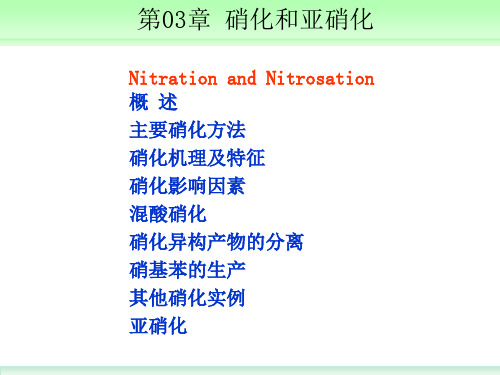
6.3 硝化机理及特征 6.3.1 硝化活性质点和反应机理
主要的硝化剂有不同活性硝酸、混酸、硝酸盐和硫酸、硝 酸和醋酸或醋酐的混合物。 已证实:多数硝化剂硝化反应的活性质点是NO2+(硝基阳 离子)。 当硝酸中水分增加,硝化和氧化速度均降低。但前者降低 更多,氧化副反应增加。
在稀硝酸中,硝化活性质点不是NO2+,而是硝酸中所 含微量HNO2离解生成的NO+。 在乙酐或乙酸中硝化是NO2+— CH3COOH或NO2+。
6.5.2
设S和N表示混酸中硫酸和硝酸的质量百分数,ф表示
硝酸比,则混酸含水量=100-S-N; 硝化生成水=N/ф×18/63=2N/7ф; 则脱水值公式如下: 6.5.2.2 硝化活性因数 Factor of Nitration Activity (F.N.A.) 废酸计算含量( F.N.A.)指混酸硝化终了时,废酸中硫酸 的计算含量(质量分数)若以100份混酸为计算基准,则 当Ф≤1
例如,利用二氯乙烷溶剂,可分离1,5或1,8-二硝基萘 或二硝基蒽醌。利用环丁砜,1-氯苯,甲苯,不同组分的 混酸和不同浓度的硝酸,均可比较好的分离1,5-或1,8 -二硝基蒽醌。
6.7
其它硝化方法
6.7.1 硝酸硝化 6.7.2 酸酐硝化 6.7.3 置换硝化
6.8
重要实例
6.8.1 邻、对硝基氯苯 6.8.2 1-硝基蒽醌 6.8.3 2-二乙氧基-4-硝基-N-苯甲酰苯胺
第03章 硝化和亚硝化
Nitration and Nitrosation 概 述 主要硝化方法 硝化机理及特征 硝化影响因素 混酸硝化 硝化异构产物的分离 硝基苯的生产 其他硝化实例 亚硝化
6.1 概述 6.1.1 硝化定义
还原胺化
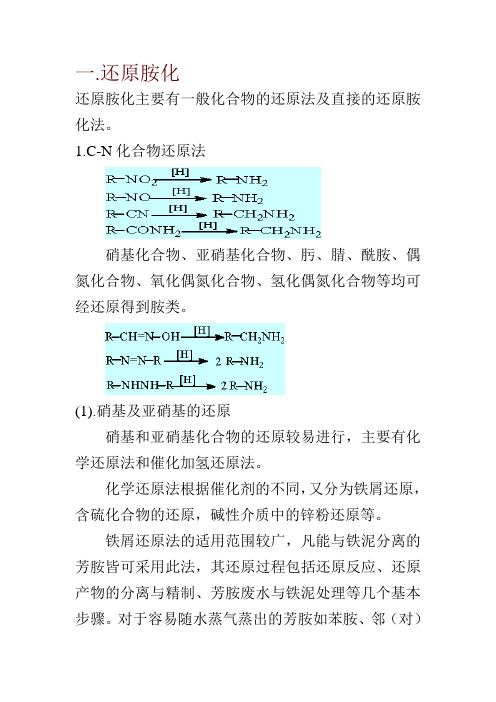
一.还原胺化还原胺化主要有一般化合物的还原法及直接的还原胺化法。
1.C-N化合物还原法硝基化合物、亚硝基化合物、肟、腈、酰胺、偶氮化合物、氧化偶氮化合物、氢化偶氮化合物等均可经还原得到胺类。
(1).硝基及亚硝基的还原硝基和亚硝基化合物的还原较易进行,主要有化学还原法和催化加氢还原法。
化学还原法根据催化剂的不同,又分为铁屑还原,含硫化合物的还原,碱性介质中的锌粉还原等。
铁屑还原法的适用范围较广,凡能与铁泥分离的芳胺皆可采用此法,其还原过程包括还原反应、还原产物的分离与精制、芳胺废水与铁泥处理等几个基本步骤。
对于容易随水蒸气蒸出的芳胺如苯胺、邻(对)甲苯胺、邻(对)氯苯胺等都可采用水蒸气蒸馏法将产物与铁泥分离;对于易溶于水且可蒸馏的芳胺如间(对)苯二胺、2,4-二氨基甲苯等,可用过滤法先除去铁泥,再浓缩滤液,进行真空蒸馏,得到芳胺;能溶于热水的芳胺如邻苯二胺、邻氨基苯酚、对氨基苯酚等,用热过滤法与铁泥分离,冷却滤液即可析出产物;对含有磺基或羧基等水溶性基团的芳胺,如1-氨基萘-8-磺酸(周位酸)、1-氨基萘-5-磺酸等,可将还原产物中和至碱性,使氨基磺酸溶解,滤去铁泥,再用酸化或盐析法析出产品,难溶于水而挥发性又小的芳胺,例如1-萘胺,在还原后用溶剂将芳胺从铁泥中萃取出来。
铁屑还原法中产生大量含胺废水,必须进行处理、回收。
例如在硝基苯用铁屑还原过程中会产生大量含苯胺废水(约含4%苯胺),一部分可加入到还原锅中循环使用,其余的要先用硝基苯萃取。
萃取后含苯胺的硝基苯可作为还原的原料使用;废水中的苯胺和硝基苯的含量分别降为0.2%和0.1%以下。
此后还必须经过生化处理,才可排放。
铁泥的利用途径之一是制铁红颜料。
含硫化合物的还原主要包括硫化碱类,如硫化钠、硫氢化铵、多硫化铵,这类反应称为齐宁反应(Zinin),该反应比较缓和,可使多硝基化合物中的硝基选择性的部分还原,或只还原硝基偶氮化合物中的硝基,而保留偶氮基,并应用于从硝基化合物获得的不溶于水的胺类。
硝化反应顺序口诀

硝化反应顺序口诀
硝化反应是一种重要的有机合成方法,它利用硝酸和有机物之间的取代反应,将有机物转化为硝基化合物。
在硝化反应中,硝基化合物与硝酸根离子(NO3-)形成的同时,还会生成一氧化氮(NO)气体。
硝化反应具有很高的反应性和危险性,因此需要遵循一定的规则和措施来确保实验的安全和成功。
硝化反应的顺序口诀是一个十分重要的诀窍,它可以帮助我们了解硝化反应中各个步骤的先后顺序,从而更好地进行实验。
这个口诀包括以下内容:
1.硝化
这是硝化反应的最基本形式,它涉及到硝酸和有机物之间的取代反应。
在这个过程中,硝酸根离子(NO3-)取代了有机物中的一个氢原子,形成了一个硝基化合物。
2.硝酸
这个步骤涉及到硝酸的准备和加入。
硝酸可以通过与有机物混合来制备,也可以通过加入盐酸来制备。
无论是哪种制备方法,都需要确保硝酸的纯度和浓度,以保证实验的顺利进行。
3.硝基化合物
这个步骤涉及到硝基化合物的生成。
在这个过程中,硝酸根离子(NO3-)取代了有机物中的一个氢原子,形成了一个硝基化合物。
硝基化合物可以分为两类:亚硝基化合物和硝基化合物。
4.一氧化氮(NO)
这个步骤涉及到一氧化氮(NO)气体的生成。
在这个过程中,亚硝基化合物和硝酸根离子(NO3-)发生反应,产生了一氧化氮(NO)气体。
一氧化氮(NO)气体具有很高的毒性和危险性,因此需要特别注意实验的安全和卫生。
硝化反应顺序口诀为我们提供了一个指导硝化反应进行的重要信息,它可以帮助我们了解和遵循硝化反应的顺序和步骤,以确保实验的安全和成功。
第五讲 硝化反应

一般来说,带有吸电子基如-NO2、-CHO、 -SO3H、-COOH等取代基的芳烃在进行硝化时, 硝基易同邻位取代基中带负电荷的原子形成σ络合物 ,所以硝化产品中邻位异构体生成量往往远比对位 异构体多。当然主产物是间位异构体。
3.2
硝化剂
不同的硝化对象往往需要采用不同的硝化方 法。相同的硝化对象如果采用不同的硝化方法则常 常得到不同的产物组成。因此硝化剂的选择是硝化 反应必须考虑的。例如乙酰苯胺在采用不同的硝化 剂硝化时所得到的产物组成出入很大,见下表。
(3)浓硫酸介质中的均相硝化法 当被硝化物或硝化产物在反应温度下是固态 时,常常将被硝化物溶解于大量的浓硫酸中,然 后加入硫酸和硝酸的混合物进行硝化,这种方法 只需要使用过量很少的硝酸,一般产率较高,所 以应用范围较广。 (4)非均相混酸硝化法 当被硝化物和硝化产物在反应温度下都是液 态时,常常采用非均相混酸硝化的方法,通过剧 烈的搅拌,有机相被分散到酸相中而完成硝化反 应。这种硝化方法有很多优点是目前工业上最常 用、最重要的硝化方法也是本章讨论的重点。
(2)活泼芳烃用硝基盐硝化
硝基硼氟酸盐NO2+BF4-的硝化能力要比混酸强得 多,可以不必考虑NO2+的生成速度对整个反应的 影响:
(3)稀硝酸硝化
芳烃首先与亚硝酸作用生成亚硝基化合物,而 后硝酸再将亚硝基化合物氧化成硝基化合物, 硝酸本身则被还原,又生成新的亚硝酸:
决定步
(4)其他硝化 (A)在醋酐中硝化 硝酸在醋酐中可发生如下反应:
3.5
相比和硝酸比
相比也称酸油比,是指混酸与被硝化物的质量 比。在固定相比的条件下,剧烈的搅拌最多只能使 被硝化物在酸相中达到饱和溶解。增加相比能使更 多量的被硝化物溶解在酸相中,这对于加快反应速 度常常是有利的。 生产上常用的方法是向硝化锅中加入一定量上 批硝化的废酸(也称为循环酸),其优点不仅是可以 增加相比,也有利于反应热的分散和传递。
第六章 硝化以及亚硝化
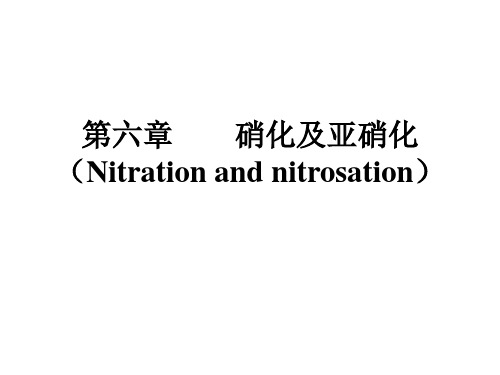
不同硝化剂对于乙酰苯胺一硝化产物的影响
硝化剂
温度/℃ 邻位% 间位% 对位% 邻位/对位
HNO3+H2SO4
20
19.4
2.1
78.5
0.25
90% HNO3
-20 23.5
-
76.5
0.31
80% HNO3
-20 40.7
-
59.3
0.69
HNO3 在醋酐中
20
67.8
6.3.3温度 硝化反应是一强的放热反应,温度上升太 快产生的影响: (1)产生多硝化、氧化、置换、断键等; (2)硝酸分解,产生NO2
硝化产物的分离
硝化异构产物的分离
5.亚硝化 反应历程,亚硝化剂,典型反应(酚、 胺类的亚硝化反应)
硝化反应中的相比是指
(1)硝酸和被硝化物的分子比; (2)混酸与被硝化物的重量比; (3)混酸和被硝化物的摩尔比; (4)混酸中硝酸与硫酸的分子比。 烷基苯或多烷基苯用混酸硝化时,若硝化条件不 适宜,硝化液会发黑变暗,其原因是:
CH3
O2N
NO2 O2N N N NO2
H2C
N
ON N
NO2
NO 2
H2C
N CH2 O2N CH2 N NO
N CH2
CH3 NO2
C(CH 3)3 NO2
2,4,6-三硝基甲苯 三亚甲基三硝胺 二亚硝基五次甲基四胺
(TNT)
(Hexogen)军用烈性炸药
(发泡剂)
人造麝香
3.工业硝化的方法
D.V
.S.
废酸含硫酸重 废酸含水重
=
混酸含硫酸重
混酸含水重 硝化生成水重
D.V.S.↑——→硝化能力↑
硝基化合物
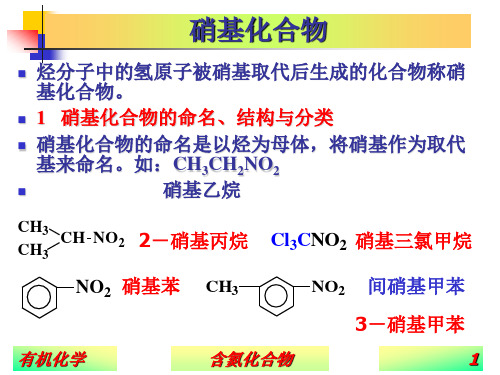
连有羰基和硝基时,只还原硝基。
NO2
SnCl2 + HCl
NH2 C HO C HO
还原结果无规 律,由实验事 实确定。
多硝基化合物在钠或铵的硫化物、硫氢化物等还原剂
作用下,可进行选择性(或部分)还原。如:
NO2 NO2
NaHS,CH3OH △
NH2 NO2
OH O2N NO2
C H3 NO2 NO2 还原对位
O
N =
δ
O Cl
O N
δ
=
O
Cl
显然,Cl原子的邻、对位上的-NO2数目↑,其亲核取代
反应活性↑。
Cl NO2
Na2CO3 130℃
OH NO2
Cl NO2 NO2
10% Na2CO3 △ , 煮沸
OH NO2 NO2
Cl O 2N NO2 NO2
H2O 沸腾
OH O2N NO2 NO2
3. 对甲基的影响 我们知道含活泼氢的化合物可以与苯甲醛缩合。显然,
NH4SH △
OH NO2 Na2S,CH3OH
△
O2N NO2
C H3 NO2 NH2
NH2
NH2 NO2 NO2 还原邻位
NH4SH △
NH2 NH2 NO2
三、 硝基对苯环的影响 硝基是强吸电子基,当其与苯环直接相连时,不仅使 芳环上的亲电取代反应活性↓,以致不能进行(如:F-C反
应),而且通过-I、-C效应,对其邻、对位的取代基产生
=
O O
R C H=N 假酸式
OH O
NaOH
R C H=N
+ O Na
O
+
H2O
有机化学
实验4硝基配合物和亚硝酸根配合物的红外光谱测定

实验4:硝基配合物和亚硝酸根配合物的红外光谱测定1. 实验目的1.1 了解红外光谱的基本原理1.2 掌握红外光谱的制样方法。
1.3 利用红外光谱图分析与鉴别硝基配合物和亚硝酸根配合物。
2 实验原理红外吸收光谱法是根据物质对红外辐射的选择性吸收特性而建立起来的一种光谱分析方法。
分子吸收红外辐射后发生振动和转动能级的跃迁,所以红外光谱法实质上是根据分子内部原子间的相对振动和转动等信息来鉴别化合物和确定物质分子结构的分析方法。
红外光谱表示方法:横坐标一般用波数(cm-1)表示,也可以用波长(微米)来表示;纵坐标可以用透射率T%或吸光度A来表示,二者的关系为:A = -lgT。
红外光谱的特点:1. 具有高度特征性,除了光学异构体外,两个结构不同的化合物,一定具有不同的红外光谱。
红外吸收的波长位置与吸收谱带的强度和形状,反映了分子结构上的特点,可以用来鉴定未知物的结构或确定化学基团;2. 分析特征性强,对气体、液体、固体试样都可以测定,并且试样需要量少、分析速度快、不破坏试样等特点。
是鉴定化合物和测定分子结构最有用的方法之一;3. 与热重、气相色谱等技术联用,拓宽了应用范围。
在有机化学、高分子化学、无机化学、化工、催化、材料、生物、医药和环保等领域有广泛的应用。
红外光谱产生的条件:1.光的频率必须与振动的频率保持一致(即满足红外吸收的公式△E=E2-E1=hv)2.在振动过程中分子偶极矩必须发生变化(即具有红外活性)红外光谱仪的发展:1.棱镜式色散型红外光谱仪(40年代)缺点:分辨率较低,测量范围限制在4000-400cm-12.光栅型色散式红外光谱仪(60年代)光栅色散能力显著增加,提高了分辨率,测量范围扩展到200cm-1,且仪器对温度、湿度等条件要求也不苛刻。
其缺点:由于辐射光需要使用狭缝控制,再经过色散到达检测器的光已经很弱,用来研究吸收强度很弱的吸收谱带和痕量分析受到限制,其远红外能量更低,得不到满意的光谱;扫描速度很慢,使红外光谱用于动态过程的研究和与气相色谱联用遇到困难,限制了红外光谱的应用。
硝基的电还原机理

硝基的电还原机理
硝基的电还原机理是一个复杂的过程,通常涉及多个电子转移步骤。
一般情况下,硝基化合物在电化学还原过程中需要特定的介质体系,如质子存在的混合介质。
在质子存在的混合介质中,硝基化合物的电化学还原通常为两步一电子的电子转移过程。
具体来说,当有质子存在时,氢键作用和质子化作用可能会影响整个电化学历程。
在这个过程中,硝基化合物首先通过获得一个电子被还原成亚硝基化合物。
随后,亚硝基化合物再通过获得一个电子被还原成氨基苯酚或其它产物。
此外,硝基化合物的电化学还原产物还取决于质子给体的氢键作用,这会导致电化学还原电位发生一定的位移。
同时,硝基化合物在某些介质体系中的电化学还原也可能涉及更复杂的电子转移过程,包括多步电子转移和质子参与的反应。
综上所述,硝基的电还原机理是一个涉及多步电子转移和质子作用的过程,具体的反应机制和产物可能因介质体系的不同而有所差异。
如需更具体的信息,建议查阅相关的化学书籍或咨询化学专家。
6 各类化合物的命名 - 上海有机化学研究所
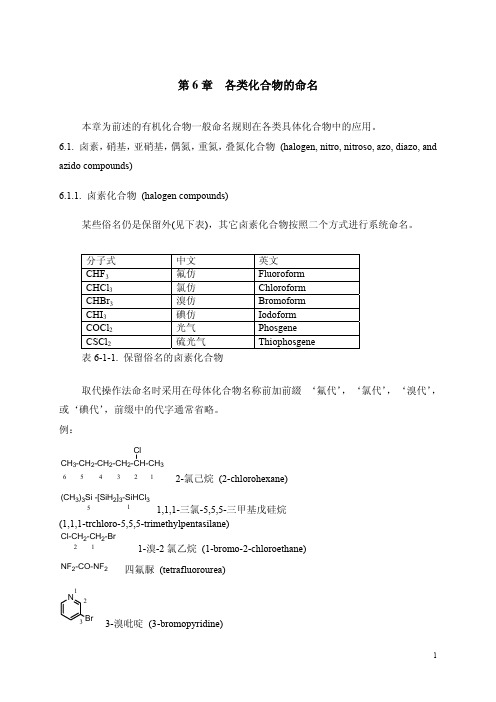
第6章 各类化合物的命名本章为前述的有机化合物一般命名规则在各类具体化合物中的应用。
6.1. 卤素,硝基,亚硝基,偶氮,重氮,叠氮化合物 (halogen, nitro, nitroso, azo, diazo, and azido compounds)6.1.1. 卤素化合物 (halogen compounds)某些俗名仍是保留外(见下表),其它卤素化合物按照二个方式进行系统命名。
分子式中文 英文 CHF 3氟仿 Fluoroform CHCl 3氯仿 Chloroform CHBr 3溴仿 Bromoform CHI 3碘仿 Iodoform COCl 2光气 Phosgene CSCl 2硫光气 Thiophosgene 表6-1-1. 保留俗名的卤素化合物取代操作法命名时采用在母体化合物名称前加前綴 ‘氟代’,‘氯代’,‘溴代’,或‘碘代’,前缀中的代字通常省略。
例:CH 3-CH 2-CH 2-CH 2-CH-CH 3Cl612345 2-氯己烷 (2-chlorohexane)(CH 3)3Si -[SiH 2]3-SiHCl 315 1,1,1-三氯-5,5,5-三甲基戊硅烷(1,1,1-trchloro-5,5,5-trimethylpentasilane) Cl-CH 2-CH 2-Br12 1-溴-2氯乙烷 (1-bromo-2-chloroethane)NF 2-CO-NF 2四氟脲 (tetrafluorourea) N Br 213 3-溴吡啶 (3-bromopyridine)官能团类别命名则由有机‘基团’后随类别名 ‘氟化物’,‘氯化物’,‘溴化物’或‘碘化物’而形成,通常‘化物’二字省略。
若需要,加上位次前缀。
例:CH 3-I 甲基碘 (methyl iodide)C 6H 5-CH 2-Br苄溴 (benzyl bromide) (CH 3)3C-Cl 叔丁基氯 (tert -butyl chloride)Br-CH 2-CH 2-Br乙叉二溴化物 (ethylene dibromide)6.1.2. 硝基和亚硝基化合物 (nitro, and nitroso compounds)含有一个–NO 2 或 –NO 基团化合物的命名可采用分别加前綴‘硝基’或‘亚硝基’。
有机化学~10含氮化合物
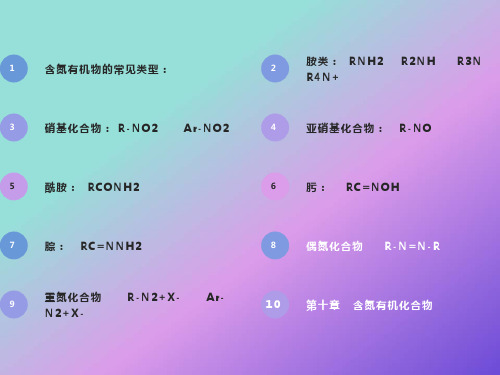
R2NH + H2O R2N+H2 + OH-
从电子效应考虑:烷基越多碱性越强; 从溶剂化效应考虑:烷基越多碱性越弱。
铵盐溶于水,不溶于有机溶剂
分离、提纯 胺
比较下列化合物碱性大小
>
>
>
供电子基团
吸电子基团
2.烃基化
胺作亲核试剂与R―X R―OH Ar―OH 反应在N原子上引入烃基。 季铵盐
3、氨基对芳环的致活作用
N原子上的孤对电子:
1、碱性
+ H X
2、亲核性
+
反应部位:
1. 碱性 结论: 所有的胺呈弱碱性 H2O < RNH2 < < OH – > RCONH2 (1)
胺
pKb
NH3 CH3NH2 (CH3)2NH (CH3)3N
4.7 3.4 3.3 4.3 9.4 13 8.7
2.卤化——速度快,溴化和氯化得2,4,6-三卤苯胺:
白色沉淀
思考: 如何鉴别苯酚与苯胺?
如何制备一溴苯胺?
制备一溴苯胺
乙酰化
溴化
水解
使苯胺活性降低!
——主要产物对溴乙酰苯胺:
例1——间位取代反应 例2——对位取代反应 硝化——注意硝酸的氧化作用和氨基的保护 氨基的保护 间位取代反应,注意条件
pH < 3.1, 红色
10.2.3 偶氮染料和酸碱指示剂
霍夫曼规则——季铵盐在消除反应中,得到的主要产物为双键上烷基最少的烯烃。
取代较少的烯烃为主要产物
反应机理: E2反应
过渡态 Hofmann 消除规律: 生成取代较少的烯烃
亚硝基化合物(本)
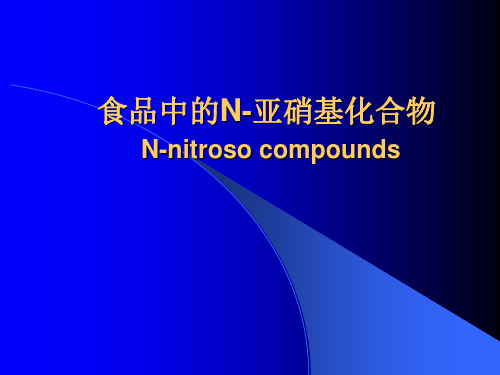
N-nitroso compounds
提纲
• 概述 • 分类、结构、性质 • 来源与形成 • 代谢与毒性 • 与人类肿瘤的关系 • 预防措施
2020/10/16
2
1.概述
N-亚硝基化合物是一类具有强致癌作用 的物质(在动物中的致癌作用已明确)
研究历史
前体物―硝酸盐、亚硝酸盐和胺类
瓜类
311 mg/kg
食用菌 38 mg /kg
薯芋类 1503 mg/kg 白菜类 1296 mg/kg 豆科 373 mg/kg 茄果类 155 mg/kg
– 不同种植条件的差异
含氮肥料过量使用 、光照不足、灌溉条件差,硝酸盐含量高 施用钼肥可降低作物中的硝酸盐含量
2020/10/16
10
亚硝酸盐的来源
– 来源于含蛋白质的食品
普遍:动物类、粮谷类、蔬菜、食品调料等 长期保存、腐败变质、食品加工(晒干、熏制、腌制、烘
烤、煎炸、发酵等)过程中
– 蛋白质分解 氨基酸 脱羧生成胺类 – 某些氨基酸,肽类、肌酸、肌酐、磷脂等
– 药物、农药、化工产品原料中的胺类物质 – 二级胺(仲胺)最容易被亚硝化
鱼肉和某些蔬菜
N-亚硝基化合物
图 N-亚硝基化合物的体内合成
21
胃
可能是人体中最主要 的合成部位
正常人胃液pH 1~4 含硝酸盐还原菌 胃酸缺乏的人
2020/10/16
17
N-亚硝基化合物的合成
亚硝化过程
可亚硝基化的胺类
+
亚硝化剂
适宜的条件下 (体内、体外)
N-亚硝基化合物
2020/10/16
18
合成条件及影响因素
亚硝基化合物的转化

亚硝基化合物可以通过多种化学反应进行转化,以下是一些常见的转化方式:
还原反应:亚硝基化合物可以被还原成羟胺或氨基醇等化合物。
例如,在酸性环境中,亚硝基化合物可以被还原成羟胺;在碱性环境中,亚硝基化合物可以被还原成氨基醇。
氧化反应:亚硝基化合物可以被氧化成硝基化合物。
例如,在酸性环境中,亚硝基化合物可以被氧化成硝基化合物;在碱性环境中,亚硝基化合物也可以被氧化成硝基化合物。
重排反应:亚硝基化合物可以发生重排反应,生成其他类型的氮氧化物。
例如,在酸性环境中,亚硝基化合物可以发生重排反应,生成硝基化合物。
总的来说,亚硝基化合物的转化主要涉及的是官能团之间的转换和迁移,这需要依据具体的反应条件和底物结构进行选择和设计。
硫化钠还原硝基苯机理

硫化钠还原硝基苯机理
硫化钠还原硝基苯的机理是指通过硫化钠还原含有硝基基团的
苯类化合物,产生相应的氨基苯化合物的过程。
具体机理如下:首先,硝基苯在硫化钠的存在下发生氢离子交换反应,生成相应的亚硝基化合物。
然后,亚硝基化合物在硫化钠的作用下发生一个还原反应,将其还原为相应的氨基苯化合物。
在这个过程中,硫化钠起到了还原剂的作用,将亚硝基化合物的氮原子上的氧化态还原为氨基化合物。
最后,氨基苯化合物可以进一步反应或用于化学合成中。
整个过程的化学方程式如下:
硝基苯 + 硫化钠→亚硝基化合物
亚硝基化合物 + 硫化钠→氨基苯化合物
总的来说,硫化钠还原硝基苯的机理是一个重要的有机化学反应,可以用于合成各种氨基苯类化合物。
- 1 -。
亚硝酸盐氧化速率 nor
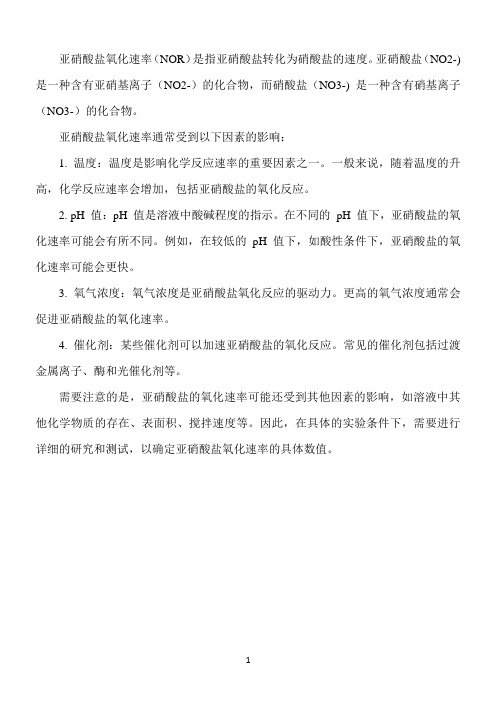
亚硝酸盐氧化速率(NOR)是指亚硝酸盐转化为硝酸盐的速度。
亚硝酸盐(NO2-) 是一种含有亚硝基离子(NO2-)的化合物,而硝酸盐(NO3-) 是一种含有硝基离子(NO3-)的化合物。
亚硝酸盐氧化速率通常受到以下因素的影响:
1. 温度:温度是影响化学反应速率的重要因素之一。
一般来说,随着温度的升高,化学反应速率会增加,包括亚硝酸盐的氧化反应。
2. pH 值:pH 值是溶液中酸碱程度的指示。
在不同的pH 值下,亚硝酸盐的氧化速率可能会有所不同。
例如,在较低的pH 值下,如酸性条件下,亚硝酸盐的氧化速率可能会更快。
3. 氧气浓度:氧气浓度是亚硝酸盐氧化反应的驱动力。
更高的氧气浓度通常会促进亚硝酸盐的氧化速率。
4. 催化剂:某些催化剂可以加速亚硝酸盐的氧化反应。
常见的催化剂包括过渡金属离子、酶和光催化剂等。
需要注意的是,亚硝酸盐的氧化速率可能还受到其他因素的影响,如溶液中其他化学物质的存在、表面积、搅拌速度等。
因此,在具体的实验条件下,需要进行详细的研究和测试,以确定亚硝酸盐氧化速率的具体数值。
1。
- 1、下载文档前请自行甄别文档内容的完整性,平台不提供额外的编辑、内容补充、找答案等附加服务。
- 2、"仅部分预览"的文档,不可在线预览部分如存在完整性等问题,可反馈申请退款(可完整预览的文档不适用该条件!)。
- 3、如文档侵犯您的权益,请联系客服反馈,我们会尽快为您处理(人工客服工作时间:9:00-18:30)。
Nitro Alkanes and Nitro ArenesStructureThe nitrogen is trigonal planar with a bond angles of 120°, there are two resonance forms so implying that the two oxygens are equivalent;Electronic EffectsThese are strongly electron withdrawing both inductively, -I, and mesomerically, by resonance, -R. This means that both the C-N s bond and the p system are strongly polarised, C d+-NO2d-.Due to the -I inductive effect of the s bond the pKa values of nitro group containing compounds can also be affected;Ph-NO2, this substituent is ortho, para directing due to the -R resonance effect of the p bond. The -I will also still operate but is less obvious here.SpectroscopyI.R.The n max for the N=O stretch is 1500-1600 cm-1, compared to the C=O stretch at 1650-1800 cm-1.NMRFor a CH protons, adjacent to the group, the chemical shift, d, = 4.3, due to electron withdrawing effect;U.V .The nitro group causes a pronounced shift of l max to longer wavelengths when conjugated to unsaturated p systems, a bathochromic shift. This is why nitro compounds are often yellow.Synthesis of Nitro-CompoundsAliphatic nitro compounds are synthesised by;Gas Phase Nitration of AlkanesThis commercial free radical process involves the NO2 radical;Electrophilic Nitration of Enolate AnionsThe use of the enolate active methylenes forms a stable product due to the chelation of the counter ion;Nitrate SN2 displacement of alkyl halidesTwo products, a nitro compound and a nitrite ester, are produced due to the sodium nitrate acting as an ambident nucleophile, either a N or O nucleophile;The use of silver nitrate produces only the nitro compound as it is not an ambident nucleophile.Oxidation with PeracidsNitro compounds can be produced by oxidised of amine by peracids;Aromatic Nitro CompoundsThese are synthesised by electrophilic aromatic substitution with NO2+ ions;ReactionsAs the nitro group is strongly electron withdrawing and shows affinity with the C=O group. Thus addition across the N=O is possible and reduction is easy.a Anionsa anions are easily formed with base and stabilised by resonance as nitronate anions, c.f. C=O enolate formation;The protons on nitro methane, MeNO2, have a pKa of 10.2, c.f. MeCOCH2CO2Et pKa 11. So in order to remove the a protons on nitro alkane an appropriate base in required.As the nitronate ion is delocalised it is a soft nucleophile and show usual reactivities of stabilised, soft, carbanions.AlkylationHenry ReactionThis reaction is analogous to the Aldol reaction;If R' is aryl the mechanism of elimination is;If R' is alkyl the mechanism of elimination is;Michael AdditionsThe Michael addition is a conjugate addition as the double bond is the soft centre of the ester, the carbonyl carbon being the hard centre. It proceeds by the following mechanism;Ambident NucleophilesNitronate anions themselves can act as ambident nucleophiles with either attack from the C, a soft nucleophile, or from the O, hard nucleophile. These will attack soft or hard electrophiles respectively;This ambident behaviour can be seen in the Nef reaction;O-alkylation is Possible with a hard alkylating agent like Meerwen's Bact, this is a Me+ source;The ambident nature of the nitro group makes it a very versatile reagent.ReductionGeneralIn principle the reduction of nitro compounds should follow the path;The reduction of nitroso groups is generally more easily achieved but the nitro group can be reduced in a number of different ways;PhotochemicallyMetal/H+ ReactionsMetals, such as Fe, Zn, Sn can be used with H+ to reduce the nitro group by a sequence of single electron transfer (SET)/protonation reactions;The mechanism for the Zn/H+ reaction is;H2/Pd SurfaceReactions H2/Pd or Pt can be used by heterogeneous H- transfer on the metal surface and then reaction with the nitro compound;Sulphur ReagentsNaSH or Na2S x or (NH4)2S2 can be used and possibly precede by SET reactions;Metal hydridesReagents like LiAIH4, but not usually NaBH4, reduce the nitro group by hydride, H-, transfer. The product will depend on the nature of the reducing agent, but the end point is ultimately an amine.Summary▪N SP2 hybridised and strongly electron withdrawing▪H acidic▪Anion reacts with E+, RBr RCHO, Henry reaction etc.▪Soft anion soft undergoes Michael additions▪Group reduced by:▪Metal/H+ (electron source)▪H-, (NaBH4 or LiAlH4)▪H2/Pd or Ni (R)Nitroso CompoundsStructureThe nitrogen is trigonal planar with a bond angle of ª125°. Nitroso compounds tend to dimerise in the following way;Electronic EffectsNitroso groups are strongly electron withdrawing, like the nitro group, but the situation is complicated by the dimerisation reaction.SpectroscopyI.R.The n max for the N=O stretch in the monomer is 1560 cm-1, in the dimer the n max for the N-O stretch is 1200 cm-1.NMRFor a CH protons, adjacent to the group, the chemical shift, d, = 4.0, due to electron withdrawing effect.SynthesisAromaticsThe synthesis of aromatic nitroso compounds can achieved by nitrosation with NO+, form HNO2, on strongly activated, electron rich, aromatics like ArNH2 and ArOH;They can also be produced from nitro compounds by reduction to the hydroxylamine then followed by oxidation;The nitroso compound comes out of aqueous solution, due to its non hydrophilic nature, and so avoids further oxidation, this is a very general method and can be used for a verity of compounds. The direct reduction from NO2-R to NO-R is not a generally feasible process though a photochemical method is known, see nitro group section.AliphaticsThe synthesis of aliphatic nitroso compounds can achieved by nitrosation of active, acidic, methylene compounds under acidic conditions, H+/NOCl, N2O3 or N2O4;Under basic conditions, C5H11ONO/NaOEt;Under neutral conditions enol silyl ether /NOCl;Another method of synthesis is by Markovnikov addition of NOX (X=Cl, NO2, NO3) to olefins.Tertiary AliphaticsTo synthesis nitroso compounds with tertiary alkyls another method has to be employed;ReactionsAddition and CondensationAs the nitrosyl group is strongly electron withdrawing and more similar to the C=O than the NO2 group There is polarisation of the N=O bond and so behaves as a weak C=O. It undergoes addition of nucleophiles and condensation with primary amines and the anions of active methylene compounds, e.g malonates, b ketoesters;The best method for preparation of secondary hydroxylamines is by addition of a Grignard reagent to a nitroso group and carrying out an acidic work up;The production of a nitrone can be seen in the following reaction;The hetero Diels-Alder reaction is also possible;ReductionReduction occurs as for NO2 groups with metals, metal hydrides, hydrogen/ catalyst.OxidationOxidation is readily brought about with peracids inter alia, this is not possible for nitro groups.Radical Addition-Spin TrappingMonomeric nitroso compounds are used to detect transient free radicals, mainly carbon centred radicals, by 'trapping' them as stable nitroxide radicals. These can be detected and assayed in an EPR spectrometer, this is the electron equivalent of the NMR spectrometer. EPR stands for Electron Paramagnetic Resonance. This allows the intermediacy of such otherwise undetectable transients to be proven and is therefore a valuable mechanistic probe.If the following thermal decomposition of benzoyl peroxide, a radical initiation reaction, is to be monitored;The phenyl radical would be undetectable by EPR but by addition of a tertiary nitrosyl the more stable nitroxide is produced which is observable;Summary▪N SP2 hybridised and electron withdrawing▪ON group like carbonyls undergoes addition with RMgX, condenses with RNH2 and 'active methllene', e.g malonate anion▪When a-H present, readily isomerises to oxime▪Very rapid addition of radicals R across N=O bond to give stable nitroxide radicals。
